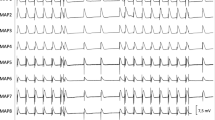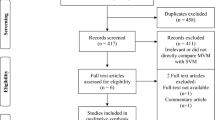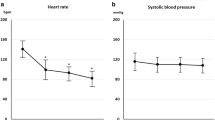Abstract
Background
Drugs used for sedation/analgesia may affect the basic cardiac electrophysiologic properties or even supraventricular tachycardia (SVT) inducibility. Dexmedetomidine (DEX) is a selective alpha-2 adrenergic agonist with sedative and analgesic properties. A comprehensive evaluation on use of DEX for reentrant SVT ablation in adults is lacking. The present study aims to systematically assess the impact of DEX on cardiac electrophysiology and SVT inducibility.
Methods
Hemodynamic, electrocardiographic, and electrophysiological parameters and SVT inducibility were assessed before and after DEX infusion in patients scheduled for ablation of reentrant SVT.
Results
The population of this prospective observational study included 55 patients (mean age of 58.7 ± 14 years, 29 males [52.7%]). A decrease in systolic and diastolic blood pressure and in heart rate was observed after DEX infusion (p = 0.001 for all). DEX increased corrected sinus node refractory time, atrial effective refractory period, AH interval, AV Wenckebach cycle length, and AV node effective refractory period without affecting the His-Purkinje conduction or ventricular myocardium refractoriness. No AV blocks or sinus arrests occurred during DEX infusion. Globally, there was no difference in SVT inducibility in basal condition or after DEX infusion (46/55 [83.6%] vs. 43/55 [78.1%] patients; p = 0.55), without a difference in isoprenaline use (p = 1.0). In 4 (7.3%) cases, the SVT was inducible only after DEX infusion. In 34.5% of cases, DEX infusion unmasked the presence of an obstructive sleeping respiratory pattern, represented mainly by snoring.
Conclusions
DEX depresses sinus node function and prolongs atrioventricular refractoriness without significantly affecting the rate of SVT inducibility in patients scheduled for reentrant SVT ablation

Similar content being viewed by others
Data availability
The data that support the findings of this study are available from the corresponding author, upon reasonable request.
Abbreviations
- AES:
-
atrial extrastimulus
- AV:
-
atrioventricular
- AVNRT:
-
atrioventricular nodal reentrant tachycardia
- AVRT:
-
atrioventricular reentrant tachycardia
- AERP:
-
atrial effective refractory period
- AVNERP:
-
atrioventricular effective refractory period
- BMI:
-
body mass index
- cSNRT:
-
corrected sinus nodal recovery time
- CS:
-
coronary sinus
- DEX:
-
dexmedetomidine
- DBP:
-
diastolic blood pressure
- ECG:
-
electrocardiogram
- EP:
-
electrophysiological
- EPS:
-
electrophysiological study
- HR:
-
heart rate
- OSAS:
-
obstructive sleep apnea syndrome
- SBP:
-
systolic blood pressure
- VERP:
-
ventricular effective refractory period
- RF:
-
radiofrequency
- SVT:
-
supraventricular tachycardia
References
Katritsis DG. Conscious sedation for diagnostic electrophysiology and catheter ablation of supraventricular tachycardia. Europace. 2019;21:3–4.
Vladinov G, Fermin L, Longini R, Ramos Y, Maratea E. Choosing the anesthetic and sedative drugs for supraventricular tachycardia ablations: a focused review. Pacing Clin Electrophysiol. 2018;41:1555–63.
Warpechowski P, Lima GG, Medeiros CM, Santos ATL, Kruse M, Migloransa MH, Kalil RAK. Randomized study of propofol effect on electrophysiological properties of the atrioventricular node in patients with nodal reentrant tachycardia. Pacing Clin Electrophysiol. 2006;29:1375–82.
Lai L-P, Lin J-L, Wu M-H, Wang M-J, Huang C-H, Yeh H-M, Tseng Y-Z, Lien W-P, Huang SKS. Usefulness of intravenous propofol anesthesia for radiofrequency catheter ablation in patients with tachyarrhythmias: infeasibility for pediatric patients with ectopic atrial tachycardia. Pacing Clin Electrophysiol. 1999;22:1358–64.
Selvaraj RJ, Dukiya S, Ananthakrishna Pillai A, Satheesh S, Balachander J. Effects of conscious sedation on tachycardia inducibility and patient comfort during ablation of supraventricular tachycardia: a double blind randomized controlled study. Europace. 2019;21:142–6.
Lau W, Kovoor P, Ross DL. Cardiac electrophysiologic effects of midazolam combined with fentanyl. Am J Cardiol. 1993;72:177–82.
Paris A, Tonner PH. Dexmedetomidine in anaesthesia. Curr Opin Anaesthesiol. 2005;18:412–8.
Hammer GB, Drover DR, Cao H, Jackson E, Williams GD, Ramamoorthy C, Van Hare GF, Niksch A, Dubin AM. The effects of dexmedetomidine on cardiac electrophysiology in children. Anesth Analg. 2008;106:79–83. table of contents
Ergul Y, Unsal S, Ozyilmaz I, Ozturk E, Carus H, Guzeltas A. Electrocardiographic and electrophysiologic effects of dexmedetomidine on children. Pacing Clin Electrophysiol. 2015;38:682–7.
Tirotta CF, Nguyen T, Fishberger S, Velis E, Olen M, Lam L, Madril DR, Hughes J, Lagueruela RG. Dexmedetomidine use in patients undergoing electrophysiological study for supraventricular tachyarrhythmias. Pediatr Anesth. 2017;27:45–51.
Pöyhiä R, Nieminen T, Tuompo VWT, Parikka H. Effects of dexmedetomidine on basic cardiac electrophysiology in adults; a descriptive review and a prospective case study. Pharmaceuticals. 2022;15:1372.
Sairaku A, Nakano Y, Suenari K, Tokuyama T, Kawazoe H, Matsumura H, Tomomori S, Amioka M, Kihara Y. Dexmedetomidine depresses sinoatrial and atrioventricular nodal function without any change in atrial fibrillation inducibility. J Cardiovasc Pharmacol. 2016;68:473–8.
Continuum of depth of sedation: definition of general anesthesia and levels of sedation/analgesia. [cited 2023 Mar 20] https://www.asahq.org/standards-and-guidelines/continuum-of-depth-of-sedation-definition-of-general-anesthesia-and-levels-of-sedationanalgesia. Accessed 5 May 2023
Correa-Sales C, Nacif-Coelho C, Reid K, Maze M. Inhibition of adenylate cyclase in the locus coeruleus mediates the hypnotic response to an alpha 2 agonist in the rat. J Pharmacol Exp Ther. 1992;263:1046–9.
Kamibayashi T, Hayashi Y, Mammoto T, Yamatodani A, Sumikawa K, Yoshiya I. Role of the vagus nerve in the antidysrhythmic effect of dexmedetomidine on halothane/epinephrine dysrhythmias in dogs. Anesthesiology. 1995;83:992–9.
Stoetzer C, Reuter S, Doll T, Foadi N, Wegner F, Leffler A. Inhibition of the cardiac Na+ channel α-subunit Nav1.5 by propofol and dexmedetomidine. Naunyn Schmiedeberg’s Arch Pharmacol. 2016;389:315–25.
Zhao J, Zhou C-L, Xia Z-Y, Wang L. Effects of dexmedetomidine on L-type calcium current in rat ventricular myocytes. Acta Cardiol Sin. 2013;29:175–80.
Behmenburg F, Pickert E, Mathes A, Heinen A, Hollmann MW, Huhn R, Berger MM. The cardioprotective effect of dexmedetomidine in rats is dose-dependent and mediated by BKCa channels. J Cardiovasc Pharmacol. 2017;69:228.
James TN. Structure and function of the sinus node, AV node and His bundle of the human heart: Part I-Structure. Prog Cardiovasc Dis. 2002;45:235–67.
Ellermann C, Brandt J, Wolfes J, Willy K, Wegner FK, Leitz P, Lange PS, Reinke F, Eckardt L, Frommeyer G. Safe electrophysiologic profile of dexmedetomidine in different experimental arrhythmia models. Sci Rep. 2021;11:23940.
Görges M, Whyte SD, Sanatani S, Dawes J, Montgomery CJ, Ansermino JM. Changes in QTc associated with a rapid bolus dose of dexmedetomidine in patients receiving TIVA: a retrospective study. Paediatr Anaesth. 2015;25:1287–93.
Chrysostomou C, Beerman L, Shiderly D, Berry D, Morell VO, Munoz R. Dexmedetomidine: a novel drug for the treatment of atrial and junctional tachyarrhythmias during the perioperative period for congenital cardiac surgery: a preliminary study. Anesth Analg. 2008;107:1514–22.
Chrysostomou C, Sanchez-de-Toledo J, Wearden P, Jooste EH, Lichtenstein SE, Callahan PM, Suresh T, O’Malley E, Shiderly D, Haney J, Yoshida M, Orr R, Munoz R, Morell VO. Perioperative use of dexmedetomidine is associated with decreased incidence of ventricular and supraventricular tachyarrhythmias after congenital cardiac operations. Ann Thorac Surg. 2011;92:964–72. discussion 972
Slupe AM, Minnier J, Raitt MH, Zarraga IGE, MacMurdy KS, Jessel PM. Dexmedetomidine sedation for paroxysmal supraventricular tachycardia ablation is not associated with alteration of arrhythmia inducibility. Anesth Analg. 2019;129:1529–35.
Mani BC, Pavri BB. Dual atrioventricular nodal pathways physiology: a review of relevant anatomy, electrophysiology, and electrocardiographic manifestations. Indian Pacing Electrophysiol J. 2014;14:12–25.
Chiou C-W, Chen S-A, Kung M-H, Chang M-S, Prystowsky EN. Effects of continuous enhanced vagal tone on dual atrioventricular node and accessory pathways. Circulation. 2003;107:2583–8.
Stellbrink C, Diem B, Schauerte P, Brehmer K, Schuett H, Hanrath P. Differential effects of atropine and isoproterenol on the inducibility of atrioventricular nodal reentrant tachycardia. J Interv Card Electrophysiol. 2001;5:463–9.
Huupponen E, Maksimow A, Lapinlampi P, Särkelä M, Saastamoinen A, Snapir A, Scheinin H, Scheinin M, Meriläinen P, Himanen S-L, Jääskeläinen S. Electroencephalogram spindle activity during dexmedetomidine sedation and physiological sleep. Acta Anaesthesiol Scand. 2008;52:289–94.
Shin H-J, Kim E-Y, Hwang J-W, Do S-H, Na H-S. Comparison of upper airway patency in patients with mild obstructive sleep apnea during dexmedetomidine or propofol sedation: a prospective, randomized, controlled trial. BMC Anesthesiol. 2018;18:120.
Vuković I, Duplančić B, Benzon B, Đogaš Z, Kovač R, Pecotić R. Midazolam versus dexmedetomidine in patients at risk of obstructive sleep apnea during urology procedures: a randomized controlled trial. J Clin Med. 2022;11:5849.
Author information
Authors and Affiliations
Corresponding author
Ethics declarations
Ethics approval
This study complies with the Declaration of Helsinki and all participants provided written informed consent.
Conflict of interest
The authors declare no competing interests.
Additional information
Publisher’s Note
Springer Nature remains neutral with regard to jurisdictional claims in published maps and institutional affiliations.
Rights and permissions
Springer Nature or its licensor (e.g. a society or other partner) holds exclusive rights to this article under a publishing agreement with the author(s) or other rightsholder(s); author self-archiving of the accepted manuscript version of this article is solely governed by the terms of such publishing agreement and applicable law.
About this article
Cite this article
Bernardini, A., Paoletti Perini, A., Padeletti, M. et al. Impact of dexmedetomidine on electrophysiological properties and arrhythmia inducibility in adult patients referred for reentrant supraventricular tachycardia ablation. J Interv Card Electrophysiol 67, 371–378 (2024). https://doi.org/10.1007/s10840-023-01640-7
Received:
Accepted:
Published:
Issue Date:
DOI: https://doi.org/10.1007/s10840-023-01640-7




